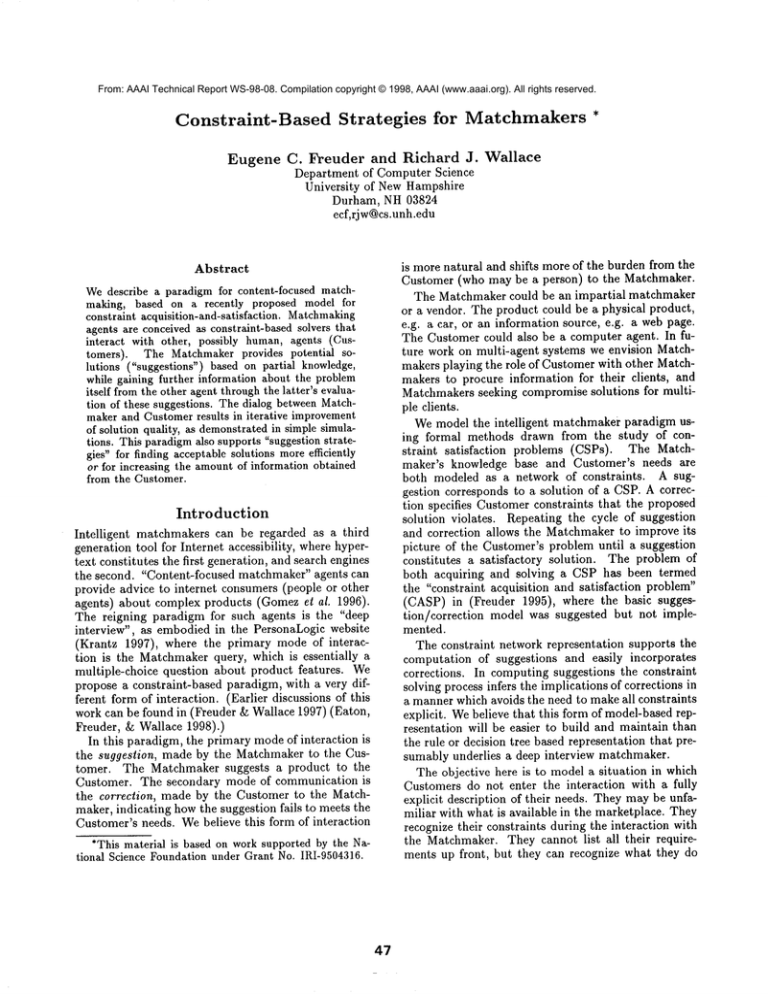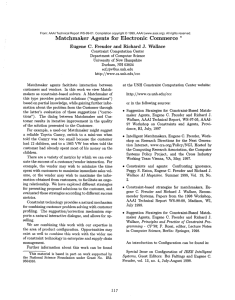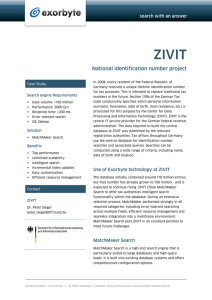
From: AAAI Technical Report WS-98-08. Compilation copyright © 1998, AAAI (www.aaai.org). All rights reserved.
Constraint-Based
Strategies
Eugene C. Freuder
for
Matchmakers
*
and Richard J. Wallace
Department of Computer Science
University of NewHampshire
Durham, NH 03824
ecf, rjw@cs.unh.edu
Abstract
Wedescribe a paradigm for content-focused matchmaking, based on a recently proposed model for
constraint acquisition-and-satisfaction. Matchmaking
agents are conceived as constraint-based solvers that
interact with other, possibly human, agents (Customers). The Matchmaker provides potential solutions ("suggestions") based on partial knowledge,
while gaining further information about the problem
itself fromthe other agent throughthe latter’s evaluation of these suggestions. The dialog betweenMatchmaker and Customerresults in iterative improvement
of solution quality, as demonstratedin simple simulations. This paradigmalso supports "suggestion strategies" for finding acceptable solutions moreefficiently
or for increasing the amountof information obtained
from the Customer.
Introduction
Intelligent
matchmakers can be regarded as a third
generation tool for Internet accessibility, where hypertext constitutes the first generation, and search engines
the second. "Content-focused matchmaker" agents can
provide advice to internet consumers (people or other
agents) about complex products (Gomezet al. 1996).
The reigning paradigm for such agents is the "deep
interview", as embodied in the PersonaLogic website
(Krantz 1997), where the primary mode of interaction is the Matchmakerquery, which is essentially a
multiple-choice question about product features. We
propose a constraint-based paradigm, with a very different form of interaction. (Earlier discussions of this
work can be found in (Freuder & Wallace 1997) (Eaton,
Freuder, & Wallace 1998).)
In this paradigm, the primary modeof interaction is
the suggestion, made by the Matchmaker to the Customer. The Matchmaker suggests a product to the
Customer. The secondary mode of communication is
the correction, made by the Customer to the Matchmaker, indicating howthe suggestion fails to meets the
Customer’s needs. Webelieve this form of interaction
*This material is based on work supported by the National Science Foundation under Grant No. IRI-9504316.
47
is more natural and shifts more of the burden from the
Customer (who may be a person) to the Matchmaker.
The Matchmaker could be an impartial matchmaker
or a vendor. The product could be a physical product,
e.g. a car, or an information source, e.g. a web page.
The Customer could also be a computer agent. In future work on multi-agent systems we envision Matchmakers playing the role of Customer with other Matchmakers to procure information for their clients, and
Matchmakers seeking compromise solutions for multiple clients.
Wemodel the intelligent
matchmaker paradigm using formal methods drawn from the study of constraint satisfaction
problems (CSPs). The Matchmaker’s knowledge base and Customer’s needs are
both modeled as a network of constraints.
A suggestion corresponds to a solution of a CSP. A correction specifies Customerconstraints that the proposed
solution violates. Repeating the cycle of suggestion
and correction allows the Matchmaker to improve its
picture of the Customer’s problem until a suggestion
constitutes a satisfactory solution. The problem of
both acquiring and solving a CSP has been termed
the "constraint acquisition and satisfaction problem"
(CASP) in (Freuder 1995), where the basic suggestion/correction
model was suggested but not implemented.
The constraint network representation supports the
computation of suggestions and easily incorporates
corrections. In computing suggestions the constraint
solving process infers the implications of corrections in
a manner which avoids the need to make all constraints
explicit. Webelieve that this form of model-based representation will be easier to build and maintain than
the rule or decision tree based representation that presumably underlies a deep interview matchmaker.
The objective here is to model a situation in which
Customers do not enter the interaction with a fully
explicit description of their needs. They maybe unfamiliar with what is available in the marketplace. They
recognize their constraints during the interaction with
the Matchmaker. They cannot list all their requirements up front, but they can recognize what they do
not want when they see it. Webelieve this to be a
commonform of customer conduct. (Picture yourself
browsing through a store or a catalogue, or interacting
with a salesclerk.)
The Matchmaker can facilitate
this process by an
appropriate choice of suggestions (tentative solutions).
For example, some suggestion strategies
may lead
to a satisfactory solution more easily for the user
than others, e.g. with fewer iterations of the suggestion/correction cycle. On the other hand, ease of use
is not the only possible goal. In some cases, it maybe
desirable for the Matchmakerto learn as muchas possible about the Customer’sconstraints, to facilitate future interactions. In many cases, the Matchmakercan
come up with a satisfactory solution before acquiring
all of the Customerconstraints. (Someconstraints will
be fortuitously satisfied by the suggestion.) Thus we
use the number of Customer constraints acquired by
the Matchmaker as another criterion when comparing
suggestion strategies.
Background:
CSPs and CASPs
A constraint satisfaction problem (CSP) involves assigning values to variables that satisfy a set of cons~raints. Each constraint is a relation based on the
Cartesian product of the domains, or allowable assignments, of a subset of variables. In the present work
all constraints are binary, i.e., they are based on the
domains of two variables. A binary CSPis associated
with a constraint graph whose nodes represent variables and arcs represent constraints.
CSPs have four basic types of parameter: number
of variables, number of values in a domain or domain
size, numberof constraints, and numberof value tuples
in a constraint. In practice, if the domainsize is the
same for all variables, we refer to it as the value of a
single domain size parameter. Otherwise, we often use
an aggregate measure like the mean as a representative parameter value. Numberof constraints is usually
expressed in relation to the total number of possible
constraints in a graph of n variables and is referred
to as problem density. Most often constraint sizes are
expressed in a complementary way, as the (relative)
number of unacceptable tuples, or tightness of a constraint. Again, if tightness varies amongconstraints,
we refer to average tightness as a representative value.
In a constraint acquisition and satisfaction problem
(CASP)the constraint solver must acquire information
about the constraints before it can solve the problem.
The situation can be conceptualized by assuming some
universe of constraints, i.e., all the constraints which
can possibly be part of the CASP. (In the extreme
case, this would be the complete graph based on the
knownvariables.) A certain set of constraints within
this universe forms the current problem, P. The CSP
solver (here the Matchmaker) knows a subset of the
constraints in P at the outset, call it K, but it must
in fact solve problem P. It will, therefore, have to ac-
48
Figure 1: The three classes of constraints that set the
scene for a Matchmakingdialog: those initially known
to both Solver and Customer (K), those known (perhaps implicitly)to the Customer(P), and the universal
set of constraints, which includes all those that might
have been part of the problem.
quire knowledge about the remaining constraints in P
before it can find a satisfactory solution in a reasonable
amount of time.
CASPs,
Agents,
and
Matchmaking
Matchmaking based on the CASPparadigm involves
two agents, the CASPSolver and the Customer. In
this situation, the Customer ’knows’ the problem to
be solved, but not so explicitly that it can tell the
Solver outright. The Solver elicits some of this Customer knowledge by suggesting a solution based on
the constraints that it (the Solver) knows about. The
Customer then evaluates the solution to determine
whether there are constraints of concern that are violated. These violations are communicated to the
Solver, which incorporates this information as constraints between the variables involved in each violation. The Solver then solves the new CSPand presents
this solution as a new suggestion to the Customer.
This communication cycle is repeated until the solution is fully satisfactory to the Customer,i.e., none of
the latter’s constraints are violated.
To get some idea of howthis might work in practice,
we will consider the following example. A customer
comesinto a real estate office looking for an apartment.
She knows that she wants a one-bedroom apartment
within a certain price range. The agent has several
apartments available, so they decide to go and have a
look at them. The first apartment they look at has
this layout:
question. In so doing we will consider the situation
in more abstract terms, even if some of the strategies
we consider are not directly applicable to an example
such as the one above, e.g. because they put too great
demands on the Customer.
If our goal is to linait the numberof iterations in the
suggestion-correction cycle, there are two approaches
we might take. One is to try to find solutions more
likely to satisfy constraints between variables, even if
these constraints are not presently in the Solver’s representation. This policy is, therefore, one of maximizing satisfaction, specifically, the numberof satisfied
constraints. An alternative, possibly more perverse,
approach is to maximize constraint violations. Here,
the policy is to find solutions that violate as many
constraints as possible so that more constraints are incorporated into the Solver’s set from the start.
Fairly straightforward methodsfor finding solutions
under either policy can be derived from current knowledge of constraint satisfaction. These methods depend
on the kind of procedure used in the solution process.
For algorithms that use complete or exhaustive search,
selecting values less likely to be in conflict with values in other variables is a reasonable method for maximizing satisfaction. To realize this strategy we can
order the values in each domain by maximumaveraged promise, where "promise" is the relative number
of supporting values in each adjacent domain (Geelen 1992). For hill-climbing or heuristic repair methods, a strategy in the same spirit is solution reuse,
i.e., starting each search with the solution obtained
earlier, after revising the information about conflicts
based on the last Customer communication. A complete search strategy that conforms to the policy of
maximizingviolations is the converse of the satisfaction strategy: choose values most likely to be in conflict (specifically, values in each domain are ordered
by minimumpromise). A corresponding hill-climbing
strategy is to search each time from a new location,
i.e., with a newset of initial values.
If our goal is to learn as much as possible about
the Customer, where "learning about the Customer"
meanslearning his or her constraints, then intuitively,
maximization strategies do not appear well-suited to
this goal, but violation strategies should serve this purpose at least as well as that of maximizingefficiency.
This in turn suggests that satisfaction strategies will be
subject to a tradeoff between the two different goals,
while violation strategies might overcome it. On the
other hand, it is not clear which kind of strategy will
be most efficient in finding an acceptable solution. If
a satisfaction method is muchbetter than any others,
then it maybe necessary to consider this tradeoff carefully.
These ideas have been supported by experiments
that simulate a Customer-Solver dialog under simplified conditions. An exampleis shownin Figure 2, using
the complete methods described above. (These curves
kitchen I bath
living
On looking it over, the customer immediately realizes that the kitchen is muchtoo small. So they go to
another apartment:
~
kitchen
ba~
living
be~
The customer finds the kitchen satisfactory, but now
she realizes she prefers having the bathroom next to
the bedroom, as it was in the first apartment. So they
look at a third apartment:
living
Apartment three satisfies all the customer’s constraints, so she deems it acceptable.
Suggestion
Strategies
In the situation just described, the agent might have
chosen to show the apartments in a different order. In
particular, after showing Apt. 1, he might have taken
the customer to see Apt. 3. In this case, the customer’s
problem would have been solved in two steps rather
than three. However,in this case the constraint involving the locations of the bedroom and bathroom would
have been satisfied fortuitously. By showing Apt. 2,
the agent discovered this constraint, thus learning more
about the customer’s problem. This is, of course, an
example of the tradeoff between the criteria of efficiency and information gain that were described in the
Introduction.
Exampleslike this give us reason to expect that the
two goals of efficiently solving the Customer’s problem and making that problem explicit are potentially
divergent. Because of this, we would like to examine heuristics from the CSPdomain that bear on this
49
(excerpt). In Money8J Technology Strategies, volume
2(3). Forrester P~esearch, Inc.
Krantz, M. February 17, 1997. The web’s middleman.
Time 67-68.
are for one problem, but the qualitative differences seen
here were found with all problems tested.) These tests
involved a strategy for satisfying constraints as quickly
as possible (max-promise) and two strategies for maximizing constraint violations: min-promise, described
above, and a series of random value-orderings (called
"shuffle"). Each curve ends when a solution is found
that satisfies all of the Customer’sconstraints.
250
- - max-promise
~ rain-promise
¯ ~ 200-’
150:
1002
" 502
0
’3’ ’5’ ’7’ ’9’ Ill ’13 II~ ’lJ ~9~l23....25
Iteration
Figure 2: Undiscovered Customer constraints after
successive iterations with three value orderings.
During early iterations, both rain-promise and shuffle discover many constraints, but the curve for the
former levels out more quickly, and this procedure also
finds a completely satisfactory solution more quickly,
so its curve is shorter. Consequently, the curve for
shuffle falls below the other curve on the eighth iteration, but it continues on for some time before finding
a satisfactory solution. The curve for max-promiseremains well above the other two throughout the dialog.
And it requires even more iterations than shuffle to
find a fully satisfactory solution. Thus, for these problems, the strategy of violating constraints satisfies both
goals, and therefore overcomesthe tradeoff between efficiency and information gain.
References
Eaton, P. S.; Freuder, E. C.; and Wallace, R. J. 1998.
Constraints and agents: Confi’onting ignorance. AI
Magazine (to appear).
Freuder, E. C., and Wallace, R. J. 1997. Suggestion
strategies for constraint-based matchmakeragents. In
Constraints and Agents: Papers from the 1997 AAAI
Workshop, 105-111.
Freuder, E. C. 1995. Active learning for constraint
satisfaction.
In Active Learning. AAAI-95 Fall Symposium Series, Working Notes, 34-35.
Geelen, P. A. 1992. Dual viewpoint heuristics for binary constraint satisfaction problems. In Proceedings
ECAI-92, 31-35.
Gomez, J.; Weisman, D. E.; Trevino, V. B.; and
Woolsey, C. A. 1996. Content-focused matchmakers
50




